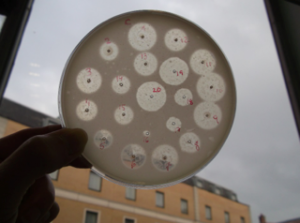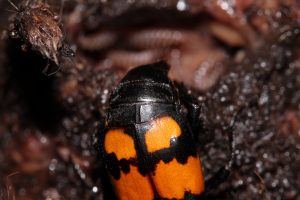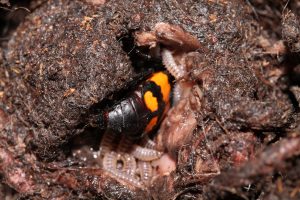The Nicrophorus genus is over 10 times more speciose than other genera in the Nicrophorinae. Its member species also exhibit far more elaborate forms of parental care than is seen in the sister genera. Could these two observations be causally related? We are using experimental evolution and selection experiments on N. vespilloides to test whether parental care facilitates evolutionary change.
Publications
Matthew Schrader, Benjamin J. M. Jarrett, Darren Rebar, Rebecca M. Kilner. Adaptation to a novel family environment involves both apparent and cryptic phenotypic changes. Proceedings of the Royal Society B doi: 10.1098/rspb.2017.1295
Benjamin J. M. Jarrett, Matthew Schrader, Darren Rebar, Thomas M. Houslay & Rebecca M. Kilner. Cooperative interactions within the family enhance the capacity for evolutionary change in body size. Nature, ecology and evolution, May 2017. doi: 10.1038/s41559-017-0178
Schrader, M., Crosby, R. M., Hesketh, A. R., Jarrett, B. J. M. and Kilner, R. M. 2015. A limit on the extent to which increased egg size can compensate for a poor postnatal environment revealed experimentally in the burying beetle, Nicrophorus vespilloides. Ecology and Evolution. doi: 10.1002/ece3.1876
Schrader, M., Jarrett, B. J. M., & Kilner , R. M. 2015 Using experimental evolution to study adaptations for life within the family. American Naturalist 185: 610-619, doi:10.1086/680500
Schrader, M., B. J. M. Jarrett, and R. M. Kilner. 2015. Parental care masks a density-dependent shift from cooperation to competition in burying beetle broods. Evolution 69: 1077-1084, doi:10.1111/evo.12615
Kilner, R. M., Boncoraglio, G., Henshaw, J. M., Jarrett, B.J.M., de Gasperin, O. & Kokko, H. 2015. Parental effects alter the adaptive value of an adult behavioural trait. eLife doi: 10.7554/eLife.07340
Attisano, A. & Kilner, R. M. 2015. Parental effects and flight behaviour in the burying beetle Nicrophorus vespilloides. Animal Behaviour 108: 91-100. doi:10.1016/j.anbehav.2015.07.020
Schrader, M., Jarrett, B. J. M., & Kilner , R. M. 2015 Using experimental evolution to study adaptations for life within the family. American Naturalist 185: 610-619, doi:10.1086/680500
Schrader, M., B. J. M. Jarrett, and R. M. Kilner. 2015. Parental care masks a density-dependent shift from cooperation to competition in burying beetle broods. Evolution 69: 1077-1084, doi:10.1111/evo.12615
Nicrophorus beetles are host to several mite species but are commonly most obviously infested Poecilochirus mites. Like the burying beetle, these mites depend on carrion to breed but lack the capability of locating a carcass themselves. So they use the beetle as a mode of transport between breeding opportunities: they don’t feed on the beetle itself, and are consequently ‘phoretic’. Once the beetle has found a carcass, the mites hop off and breed alongside the beetle. Their generation time matches the duration of parental care, and the new generation of mites hops on to the adults as they finish breeding and fly off in search of the newly dead.
We are interested to know
• whether the mites are competitors on the carcass or whether they are somehow beneficial to the burying beetle
• how the extent of mite infestation affects social interactions within the family
This research is being carried out by Ana Duarte and Syuan-Jyun Sun
Publications
Ana Duarte, Sheena C. Cotter, Ornela De Gasperin, Thomas M. Houslay, Giuseppe Boncoraglio, Martin Welch & Rebecca M. Kilner. No evidence of a cleaning mutualism between burying beetles and their phoretic mites. Scientific reports. doi: doi:10.1038/s41598-017-14201-6
Social immunity, as we have defined it (Cotter & Kilner 2010 Behav Ecol), is any sort of immune defence mounted by one individual for the benefit of others. (It is different from the more familiar personal immunity, where the immune system defends only the body in which it resides).
Burying beetles have a social immune system because they smear the carcass with antimicrobials for the benefit of their offspring, as well as themselves. Female beetles modulate the potency of their social immune response in relation to the scale of the threat that microbes pose to the carcass – upregulating the production of antimicrobials only when presented with a carcass (Cotter & Kilner 2010 J Anim Ecol), and in response to a greater bacterial load on the carcass (Cotter et al 2010). They have good reasons for using their social immune system so carefully. The more potent the antimicrobial exudates they produce, the lower their future reproductive success (Cotter et al 2010). Indeed, males try to avoid sustaining these costs themselves, passing them on to their partner instead (Cotter & Kilner 2010). In addition, their personal immune function must be balanced against social immune function. Wounded beetles, with upregulated personal immune systems, are less effective at mounting a social immune response (Cotter et al 2013).
Now that we understand better the costs involved in social immunity, we are interested in the detailed way the social immune system functions. For example:
• What are the active antimicrobial agents, besides the lysozyme we identified initially (Cotter & Kilner 2010)?
• What are the effects of these antimicrobials on the microbial community that might naturally infest the carcass?
Our work on social immunity was started by Sheena Cotter, who is continuing her research on insect immune function as a Senior Lecturer at the University of Lincoln.
In our lab, research on this topic is carried out by Ana Duarte, in collaboration with Martin Welch and Peter Davenport (Department of Biochemistry, Cambridge) (http://www.bioc.cam.ac.uk/people/uto/welch)
Publications
Ana Duarte, Martin Welch, Chris Swannack, Josef Wagner, Rebecca M Kilner. Strategies for managing rival bacterial communities: lessons from burying beetles. Journal of Animal Ecology July 2017 doi: 10.1111/1365-2656.12725
Ana Duarte, Martin Welch, Josef Wagner, Rebecca M Kilner. Privatization of a breeding resource by the burying beetle /Nicrophorus vespilloides/ is associated with shifts in bacterial communities. doi: 10.1101/065326
Ana Duarte , Sheena C. Cotter, Catherine E. Reavey, Richard J. S. Ward, Ornela De Gasperin, Rebecca M. Kilner. 2016. Social immunity of the family: parental contributions to a public good modulated by brood size. Evolutionary Ecology. doi:10.1007/s10682-015-9806-3
W. J. P. Palmer, A. Duarte, M. Schrader, J. P. Day, R. M. Kilner, F. Jiggins: a gene for social immunity in the burying beetle Nicrophorus vespilloides? biorxiv.org, doi: http://dx.doi.org/10.1101/020644
Cotter, S. C., Littlefair, J. E., Grantham, P. J. and Kilner, R. M. (2013) A direct physiological trade-off between personal and social immunity. J Anim Ecol 82:846-853
Cotter, S. C., Ward, R. S. J., and Kilner R. M. (2011) Age-specific reproductive investment in female burying beetles: independent effects of state and risk of death. Funct Ecol 25:652-660
Cotter, S. C., Topham, E., Price, A. J. P. and Kilner (2010) Fitness costs associated with mounting a social immune response. Ecol Lett 13:1114-1123.
Cotter, S. C. and Kilner R. M. (2010) Personal immunity versus social immunity. Behav Ecol 21:663-668.
Cotter, S.C. and Kilner, R. M. (2010) Sexual division of antibacterial resource defence in breeding burying beetles, Nicrophorus vespilloides J Anim Ecol 79:35-43
We are currently exploring new methods of analysing the breeding behaviour of Nicrophorus beetles using video tracking and audio processing techniques. We have a created a set of software scripts in Python 2.7 and Matlab to facilitate this.
We record beetle audio using a pair of Sennheiser ME 66 condenser microphones channeled through a two channel USB audio interface plugged into a laptop. In order to record 100+ hours of audio, we wrote a python script (store_audio_2channels.py) to record the audio and store it on disk in one hour time-stamped WAV file chunks. For convenient analysis, we then split the recording into two separate streams (one for each channel) using a Matlab script (SplitAudioChannels.m) and store the output as compressed FLAC files.
The video is recorded using a pair of Venus 2.0 infrared USB cameras and the commercially available software VideoVelocity. We store 1 frame a second and split the recordings into one hour chunks once again. Each recording is stored as a compressed WMV file and we store five of our single frames into each second. You can see some examples of the recordings we made in the crypt.
Some of our beetles:
Image credit: Benjamin Jarrett
Nicrophorus vespilloides female
Image credit: T Houslay
The lab population
Nicrophorus vespillo
Nicrophorus vespilloides close up
Nicrophorus vespilloides parental care
Nicrophorus feeding young
Videos
Recorded live action from a developing N. vespilloides family! Check out our YouTube channel.












